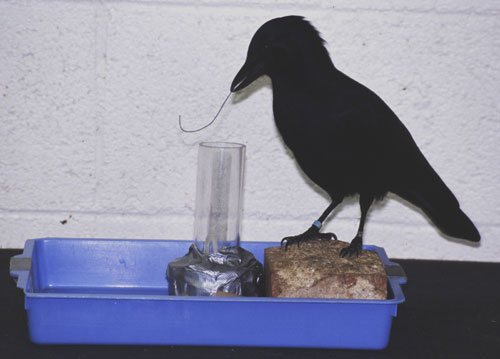In the realm of animal intelligence, crows have emerged as fascinating subjects due to their remarkable problem-solving abilities and adaptive behaviors. One extraordinary example is Betty, a crow whose ingenuity captured the attention of scientists when she demonstrated a complex tool-use behavior previously believed to be exclusive to humans and great apes. This behavior not only highlights the cognitive prowess of crows but also challenges our understanding of animal intelligence and the evolutionary origins of tool use.
Betty’s Remarkable Feat:
Betty, a captive crow involved in a study, astounded researchers by bending a straight piece of wire into a hook. This innovative act was part of an experiment where the crow needed to retrieve a basket of food from a tube—an intricate task that required planning, problem-solving, and fine motor skills.
Tool Use in the Animal Kingdom:
The use of tools was traditionally considered a defining trait of human intelligence. However, observations like Betty’s demonstrate that certain animals, including crows, possess the cognitive abilities necessary to create and utilize tools for specific purposes. This challenges conventional notions of animal cognition and prompts further investigation into the complexity of non-human intelligence.
Implications for Understanding Avian Cognition:
Betty’s behavior underscores the sophisticated cognitive abilities of crows, suggesting they are capable of not only using tools but also adapting their behavior based on environmental challenges. Such skills are crucial for survival in the wild and highlight the adaptive advantages of intelligence in birds.
The Evolutionary Perspective:
Studies on tool use in crows provide insights into the evolutionary origins of intelligence across species. By examining how crows innovate and problem-solve, researchers gain valuable clues about the development of cognitive skills and their role in shaping animal behavior over time.
FAQ:
How did Betty learn to use the wire as a tool?
Betty and other crows learn tool-use behaviors through observation and trial-and-error. In the study, Betty likely observed the use of the wire by researchers or other crows and applied that knowledge to solve the problem of retrieving food.
Are other crows capable of similar tool-use behaviors?
Yes, studies have documented various tool-use behaviors in crows and related species. These behaviors vary depending on the environment and the specific challenges faced by the birds.
What does Betty’s behavior teach us about animal cognition?
Betty’s ability to fashion a tool from a wire to solve a specific problem demonstrates advanced cognitive skills, including planning, innovation, and the ability to understand cause and effect. It suggests that crows possess a level of intelligence previously underestimated in birds.
Betty’s ability to fashion a hook from a straight piece of wire to retrieve food exemplifies the remarkable cognitive abilities of crows. This behavior challenges traditional views on animal intelligence and invites further exploration into the complexities of avian cognition. As scientists continue to study these intelligent birds, such as Betty, they uncover new dimensions of animal behavior and cognition that deepen our appreciation for the diversity of intelligence in the natural world.







